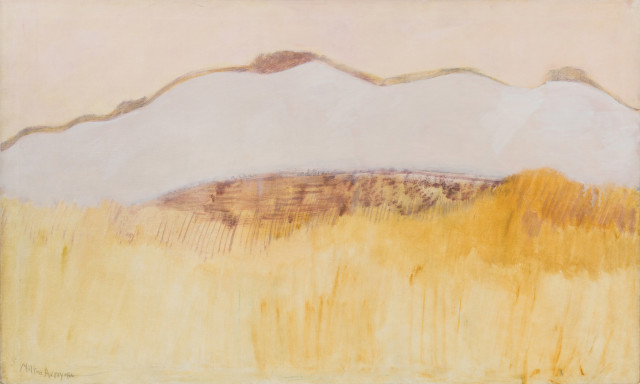
Milton Avery
Yellow Grasses, Gray Dune, 1962
Oil on canvas
76.2 x 127 cm
30 x 50 in
30 x 50 in
The last great summer experience was Provincetown. The bay, the dunes, the beaches – all combined to enchant and to stimulate a flowering of creativity in Milton. The series of large canvases produced mark the pinnacle of his entire painting career. One cannot look at the dunes, now, without taking into account his vision. Sally Michel Avery quoted in Bonnie Lee Grad (1990) Foreword.
In 1962, Avery painted several works with Cape Cod motifs, over a year after his last days in Provincetown – among them Yellow Grasses, Gray Dune; Sea and Dunes; and Dune Grasses and Quiet Sea. The artist is shown finishing Dune Grasses and Quiet Sea in his Central Park West studio – applying paint to the canvas with a soft cloth rather than a brush – in Warren Forma’s film “The Americans: Three East Coast Artists at Work (Milton Avery, Hans Hofmann, Jack Tworkov)”.
These late canvases portray their motifs as something remembered with tenderness. Visually, they are softened, the landscape seen through a subtle haziness. Barbara Haskell has written, of Avery’s late paintings, “Toward the end of Avery’s life a quality of detachment andnostalgia overlaid his visual memories….Avery achieved this through radically muted color and pictorial distancing. The device of aerial perspective…and…the frequent placing of images in the middle ground rather than the foreground of the canvas served to separate the image from Avery’s, as well as from the spectator’s space--creating the sensation that the scene was being viewed from afar. By combining these techniques with the veiled, slightly mottled softness of his colors, Avery placed his subjects at an enigmatic distance.” Barbara Haskell (1982) pp. 164, 169-70
Yet, despite their elegiac quality, the armature of compositional mastery in Avery’s late canvases never falters. In 1952, Avery was quoted in an article by Chris Ritter, one of very few occasions when he commented about his work: “Today I design a canvas very carefully before I begin to paint it. The two-dimensional design is important, but not so important as the design in depth. I do not use linear perspective, but achieve depth by color – the function of one color with another. I strip the design to essentials; the facts do not interest me as much as the essence of nature.” He goes on to explain that his concern is time and space. “Objects in nature, whether static or in motion, are seized at a fleeting moment as in a snapshot, and translated into abstract color and form. Each composition is a struggle. Reading a mystery thriller or sitting in a rocking chair smoking his pipe, Avery is mentally designing his next picture. Thus, before he steps to the easel and is confronted by the bare canvas, his picture is almost completely planned, and only the comparatively simple act of applying paint remains.” Milton Avery quoted in Chris Ritter (1952)
Exhibitions
Milton Avery: Edge of Abstraction, Knoedler & Company, New York, NY, November 10, 1999 - January 22, 2000
Milton Avery and the Sea, Alpha Gallery, Boston, MA, November 4 - November 29, 2006
Milton Avery: The Last Decade, Riva Yares Gallery, Scottsdale, AZ, February 16 - March 31, 2008
Publications
Polcari, Stephen. Milton Avery: Edge of Abstraction, Knoedler & Company, New York, NY (1999). Listed, n.p.
Cohen, David. Milton Avery: The Last Decade, Riva Yares Gallery, Scottsdale, AZ (2008). Listed p. 56; illustrated p. 30.